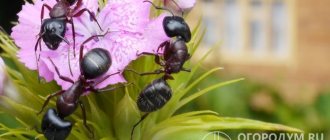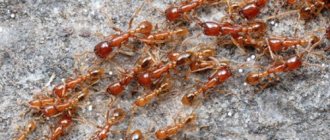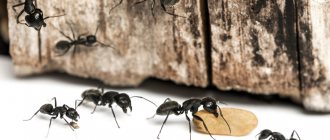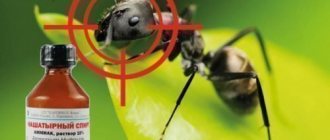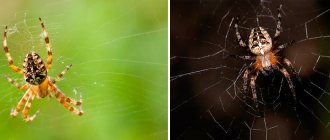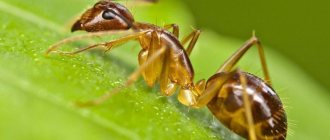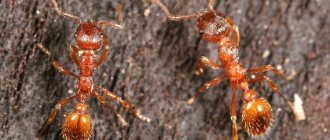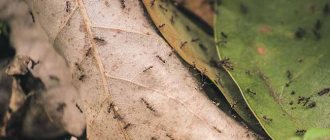The appearance of ants in the garden causes a lot of trouble. These small insects themselves are not so harmful, but they carry aphids, which destroy all vegetation. Goosebumps can eat the root system of young seedlings. Less significant, but no less unpleasant, damage from insects is the spreading of weed seeds throughout the area. You should start fighting for the safety of your harvest as quickly as possible. One of the effective home methods is semolina against ants, which, moreover, is also harmless to the seedlings themselves, which cannot be said about chemicals.
Garden ants spoil the berry harvest
How does semolina work on ants?
While relaxing at the dacha, you may encounter clusters of insects near trees and bushes with sweet berries and fruits. Ants choose cherries or gooseberries - the sweeter the fruit, the more likely an anthill will appear at its roots. Such a neighborhood, contrary to stereotypes, has a bad effect on plants.
In fact, semolina will not become poison for the insect - ants eat sweet semolina with pleasure, and most often they bring the treat to the queen. In the pest's stomach, the croup swells, causing its body to rupture and the insect to die.
On a note! If the queen dies, the entire colony will not be able to exist and will leave the summer cottage.
This cheap (compared to professional chemicals) folk method for pest control works flawlessly and contributes to the complete destruction of the colony.
What do garden ants not like, are they afraid of, what plants scare them away?
These insects, like many others, do not like strong odors, as well as the smell of essential oils. Therefore, this information can be safely used to combat ants.
So, to repel such insects, you can use the following products and plants:
- Lavender
- Mint and lemon balm
- Rosemary
- Spicy greens
- Essential oil of lemon, mint, pepper, pine needles
- Yeast
- Soda
- Salt
- Cinnamon
Essential oils are more suitable for fighting insects in houses and apartments, because they are convenient for treating doorways, windows, etc.
Lavender repels ants
But it is better, of course, to use plants on a personal plot. They can be used to plant free areas of the garden and garden, and you can also decorate borders around the beds with various crops. It looks beautiful and is useful around the house. If desired, you can use decoctions of herbs and crops to spray areas where these insects live, but the effectiveness of this method is not very high.
It is important to know that plants with pungent odors do not affect the life of ants in any way. They act in a different way
The smells of the crops attract other animals, which destroy the aphids. And since there is no longer any main food left for the ants on the site, they are forced to leave it.
Rules of application
Ants need to be destroyed in the spring or early summer, when they just wake up from hibernation and begin to be active. It is necessary to find a breeding ground for ants and generously sprinkle semolina around it - this way the insects will not be able to bypass the “bait”.
Note! The area can only be processed in dry and windless weather. Otherwise, the grains may be blown away from the garden or get wet due to rain.
The so-called “ant passages” should be treated with cereal - they are easy to notice by looking around the space near the insects’ home. These are deep paths along which pests move during the day.
We will have to “neutralize” other favorite places of pests - sweet plantings in the garden and greenhouses.
To effectively get rid of ants using semolina, after processing it will have to be covered with earth and branches to hide it from birds. At the same time, the treat will remain accessible to insects.
Within a few days, the decrease in the population will become noticeable; the final elimination of the pest will occur in 1–1.5 weeks.
Ants in the garden and garden, features of existence
We really regard black garden ants as garden pests. They don't build tall anthills. Their habitat can be seen by small holes in the ground.
Garden anthill at the dacha - entrance
In summer, these insects begin to feed on the sweet secretions of aphids. Together with aphids they form certain communities. The black garden ant protects aphids from various enemies. And she has a lot of enemies. Starting from ladybugs, ending with small birds, which are also not averse to feasting on aphids. Of course, ants won’t drive away a bird, but they can do that with a ladybug. If you are lucky, you will be able to see how together they will dislodge a ladybug from a branch covered with aphids.
In our gardens and greenhouses, ants and aphids are usually inseparable. Lately there have been a lot of aphids on weeds and cultivated plants too. Aphids suck the juice from the leaves and stems of plants, thereby causing great harm to the future harvest, and they themselves secrete a sweet milk that attracts ants. There are ants where there are a lot of aphids.
Of course, the gardener receives the main damage from aphids. But ants spread aphids, their eggs to garden plants, and drive away from the aphids those predatory insects that feed on the aphids themselves. Therefore, if nothing is done, the aphids will multiply quickly. And that’s all the goosebumps need – the “pastures” are increasing, and they are not in danger of starvation.
If you decide to fight ants, then it will be impossible to do this without paying attention to aphids, depriving the ants of their food supply. I warn you right away that it is neither possible nor necessary to completely defeat the black garden dwellers.
But reducing their number, and at the same time reducing the risk of our plants being damaged by aphids, is something we can do.
There are many ways to do this.
Additional Ingredients
If there are too many insects in the area, one decoy against ants in the garden may not cope with the removal. In this case, specific additives will come to the rescue, which will increase the ants’ attention and interest in the poison.
Sugar
Ants love sweet foods, so semolina can be mixed with sugar in a ratio of 1:3 or 1:5, depending on the number of pests. Treat the same areas with this composition (anthill, sweet garden crops and ant paths).
In this case, the likelihood that the delicacy will be eaten by the queen will increase several times.
On a note! Powdered sugar has a more effective property than sugar - due to its crushed structure, it is quickly swallowed by insects along with semolina.
Honey and jam
Sticky sweet additives such as jam and honey also have similar properties to sugar. They remove ants well, but are not so convenient and practical. In addition, the cost of such products is much higher than the price tag of 100 g of powdered sugar.
Honey or jam should be mixed into semolina carefully and in small quantities, in an approximate ratio of 1:10, to prevent the grains from sticking together into large lumps, which will be difficult for ants to chew.
A mixture of soda and semolina
An excellent alternative would be a mixture of soda and semolina, which, in addition to its direct effect, will help attract insects to a more effective remedy - sodium bicarbonate, or baking soda.
It produces an oxidizing effect on the internal organs of ants, as a result of which they disintegrate and the insect dies.
Mix soda and semolina in equal quantities; you can also add a spoonful of powdered sugar to the product - it will help to quickly attract the attention of the pest to the poison. This method can also be used in an apartment - treat areas where dead pests accumulate with the resulting preparation, and after a few days carry out wet cleaning.
Millet
Another cereal that promises to completely get rid of ants on the site. I came across this recipe after I tried semolina. I was somewhat skeptical about it, but decided to try it too.
According to the recipe, you need to pour boiling water over millet for 10–15 minutes, add something sweet (sugar, honey or jam) to this mixture and place such bait in places where ants accumulate.
What's the result?
Everything was done according to the recipe, sweet millet baits were placed near the ant holes and on their way to my cucumber bed. They took something with them, but most of the millet from the bait remained in its place. But the ants never stopped running around the garden and destroying everything in their path.
The method didn't suit me either. I decided to look for something more lethal and found it.
Alternative methods
Mixtures with semolina are not the only way to poison harmful insects. There are several other folk remedies that cope with this task no worse than semolina.
Mixture of sugar and yeast
Yeast cannot directly affect the body of ants, so you should not expect a magical result from this method. Nevertheless, it is quite effective.
A solution of sugar and yeast is mixed in a one to one ratio with the addition of a small amount of water. From the resulting mass, small balls are formed, which are laid out on “ant paths”.
Harmful insects really love the smell of yeast, so they will gladly drag the treat into the anthill. In pantries, the product will ferment, which will ruin the quality of all stored products. As a result, the insects will starve to death.
This method can also be used in apartments.
Hot peppers
You can control the pest using ground red pepper. The powder scatters near the anthill and along the notorious “ant paths.” When ingested by an insect, it burns the internal organs, causing the insect to die.
Cinnamon
Another budget product that insects are afraid of is ground packaged cinnamon. In order to get rid of annoying pests on the site, you need to dilute a sachet of the product with one or two liters of water with sugar and pour the resulting solution onto the anthill.
As in the case of yeast, fermentation processes are activated, as a result of which the ants will be forced to leave the summer cottage.
If insects attack in your apartment, simply sprinkle the areas where they are most concentrated with dry cinnamon powder. It smells aromatic, which will attract pests, and has a similar effect on the body as red pepper.
Mustard powder
The smell of mustard powder repels ants. It can be used either dry or as a solution (100 g per 10 liters of water, spray all plants in the garden once every two weeks).
3 effective ways to use mustard against ants
A mixture of powder and coffee works well. This product is also not loved by harmful ants. Mix the ingredients in a 1:1 ratio and treat the anthill itself and the “ant paths”.
Millet
Millet groats are an analogue of semolina. There is no main version why these insects do not like semolina. Most gardeners agree that when it enters the ant’s body, the cereal swells and tears the insect’s body. In addition, if millet gets into storage, at the first rain it will cause clogging of the tunnels and passages of the nasty pest due to its increase in size.
For maximum effectiveness, before use, 500 g of cereal should be soaked in lukewarm water for 10–15 minutes, then add 100 g of powdered sugar, honey or jam for sweetness. You can only remove ants in this way in the garden; pests accustomed to “kitchen” food are unlikely to pay attention to millet.
Boiling water
Filling an ant's home with boiling water is one of the easiest ways to combat ants. One bucket will be enough for a one-time treatment; it is better to get rid of harmful insects in this way for several days in a row, treating the anthill with buckets of boiling water.
A more effective option would be to prepare a saline solution - adding three kg of table salt to a bucket of boiling water (10 kg). Treating harmful ants at home with this preparation is many times more reliable than the method described above.
Millet and semolina in the fight against ants
Millet groats are the peeled fruits of cultivated millet species.
Operating principle
The principle of action of millet on ants is not fully known. There are three theories:
- Insects mistake the grains for ant eggs and carry them to the nest, where the grains expand under the influence of humidity and clog the passages. As a result, the queen dies of starvation;
- After reaching the lower layers of the anthill, soil fungi settle on grains of millet under the influence of moisture. Such grains scare away ants and they leave the nest. Perhaps these fungi are dangerous for them, or maybe they just don’t like the smell;
- The most common theory is that ants eat millet, after a while it swells in their stomachs and the insects die. When the grains are brought to the queen, the same thing happens to her. This version is most applicable to semolina.
Semolina is obtained by grinding wheat grains
Application
Whatever is true, millet and semolina actually help against ants. The use of cereals is simple:
You can sprinkle semolina or millet throughout the area, paying special attention to ant paths, places near berry bushes, garden roses, and fruit trees. It’s great if you find an ant’s nest - you should put the most generous portion there. Sometimes ants can ignore grains
To make them more attractive to insects, semolina or millet is mixed with sugar, because ants love sweets: Take a glass of powdered sugar per kilogram of cereal, mix everything well; The millet is soaked in hot water for a couple of minutes (no longer needed, it should swell until the end only in the ants’ stomachs) and jam, jam, honey, syrup or molasses are added. The resulting mass is laid out near the nest. In principle, you can mix sweet ingredients with dry semolina.
You can try using a combination of cereals: for example, scatter dry semolina over the area and place sweet millet near the nest. It is better to fight pests in spring and early summer, when they have just woken up and have not had time to cause much damage to the area. To prevent birds from pecking the cereal, you can lightly sprinkle it with soil, leaves, dry pine needles, etc.
Ants raise aphids like cattle: they are attracted to the sweet secretions of pests
What else do you need to know about ants?
If you have aphids on your property, then ants will also live there, since aphids are a source of sweet honeydew. In this case, you need to decide how to get rid of aphids on peonies. The following options are suitable for this.
Option 1
You can get rid of aphids on peonies or other plants in this way:
- Take 2 kg of spruce or pine needles.
- Place them in a bucket.
- Fill them with 8 liters of water.
- Place the bucket in a dark place for 5-7 days.
- Stir this infusion every day.
- Treat peonies and the soil around them with a spray bottle in the morning and evening for several days.
- Make sure the aphids are gone.
Option 2
Make a fairly easy-to-prepare tincture against aphids this way:
- Take 400g of fresh dandelion leaves or 300g of its roots.
- Grind and fill them with 10 liters of warm water.
- Let it brew for 2-3 hours.
- Strain the resulting infusion.
- Treat the plant with it.
Option 3
If you don’t know how to get rid of aphids using vinegar, proceed as follows:
- Take 1 tbsp. vinegar essence.
- Add it to a bucket of clean water.
- Mix the resulting solution thoroughly.
- Proceed to treat the plant infected with aphids.
Option 4
Garlic is a good remedy for fighting aphids. Apply it like this:
- Chop 30g garlic.
- Using a grater, make shavings from 4g of laundry soap.
- Pour these ingredients into 1 liter of warm water.
- Treat the plants with the resulting solution.
The opinion of summer residents
To finally be convinced of the effectiveness of the method, you can read reviews about decoy from ants. To a greater extent they are always positive.
For a whole month, ants were at work in the dacha. To fight, they tried to use plants that ants are afraid of: garlic and tomato tops. There were fewer pests for a day or two. After which the population grew again. On the advice of a friend, I tried mixing semolina with powdered sugar and sprinkled it on an ant’s nest. The result by day 4 was amazing. The ants disappeared completely.
Arina Dmitrievna, Sevastopol
We always use millet or semolina to fight ants in our summer cottage. This method does not get rid of ants forever, but you can cope with the problem. After treatment for 3-4 weeks, not a single ant. Then they could appear again, I had to re-sprinkle the cereal.
Victor Sergeevich, Novomoskovsk
Other folk remedies
Borax solution
In the event that millet cereal or semolina do not help against ants or have stopped helping, domestic summer residents still have plenty of folk methods in their assortment. You can fight ants that have multiplied in an apartment, garden or greenhouse using substances that have a strong odor. To do this, insects are dispersed in the area of distribution:
- boric acid;
- cinnamon;
- lemon juice;
- cheap perfume;
- mustard powder;
- red pepper powder;
- kerosene;
- borax solution;
- nicotine water;
- vinegar.
To clear the area of rapidly multiplying insects, garlic arrows, anise and tomato leaves are left near their colonies. In gardens, frequent loosening and sprinkling of slaked lime or ash also helps. The effectiveness of a particular method depends on the type of insects that tolerate various means of combating them better or worse, air temperature, weather conditions, humidity and precipitation. To find the most effective method for a particular situation, you can alternate approaches, however, in an advanced situation with insects spreading indoors, it is better to call parasite control specialists.
Super bait that destroys ants
Like the first version of the ant repellent, the composition includes semolina. But this recipe is more lethal than the first.
Compound:
- Dry yeast.
- Semolina.
- Powdered sugar.
- Any remedy for ants (you can do without it, but in this case the effect will be 100%).
I mixed all the ingredients 1:1 and scattered them a little around the beds, ant paths and their houses.
What is the result?
Literally after 2 days, the ants completely disappeared from the areas where such “poison” was scattered. Alas, these insects do not leave the site forever and periodically reappear.
To scare away “invading” ants from my site, I used the same composition as a preventive measure, but without poison (that is, without the last point from the composition above).
I know another good remedy for ants that contains boric acid, but there will be material about this later.
By the way! For the 4th year now, I have been ordering seeds for my plot by mail - here , and seedlings of shrubs, roses and tuberous plants - here. Everything always comes quickly, and the harvests delight with excellent results.
Don't forget to RATE THIS ARTICLE WITH A THUMBS UP
I will be very pleased!)))
Where do ants come from in the garden, and is it necessary to fight them at all?
Back in school, in biology lessons, we were all taught that ants are very useful insects. Of course, one cannot underestimate the importance of these insects on a planetary scale, but when you see an aphid that has eaten the ovaries of fruit trees on your site or the favorite flowers of the garden owner dying from aphids, you become despondent. But ants are to blame for all these troubles, because they are the ones who carry both the aphids themselves and aphid eggs throughout the plants, and, most importantly, place them on new growth, where the leaves are the softest, and thereby harm your plants even more. garden and vegetable garden.
The ants themselves do not feed on aphids: they love to feast on the sweet secretions that the aphids, in turn, produce by sucking the juice from the leaves of your favorite plants. And, of course, every gardener asks the question - what to do? How to get rid of ants, which in an instant turned from beneficial insects into hated enemies?
Ants and aphids on plants in the garden in the photo
Not all ants are gardener's enemies
Here it is worth saying in defense of all ants that the gardener’s enemies are precisely garden ants, so you should not crush with your feet all the ants that come to hand, or rather, under your foot, in the forest. It is garden ants that live underground and diligently eat up the roots of plants and trees.
Red and black garden ants in the garden: benefit or harm
These insects not only cause harm, they know how to be useful. Their presence is both pleasing and saddening, so it is impossible to say unequivocally what is more from these animals, benefit or harm.
- Ants do a good job of protecting themselves. This manifests itself in the destruction of various caterpillars, mites and larvae.
- These insects loosen the soil well with their moves, thereby improving living conditions for many rooted plants. Also, thanks to these animals, soil fertility significantly increases. It is the ants that help increase minerals in the soil.
- Also, these insects perform the function of spreading seeds of various crops, for example, celandine, thyme.
- Well, and finally, one more fact. Ants are the food of many birds. Living in gardens, insects attract songbirds to your garden, thereby filling the area with beautiful sounds.
Ants in the garden have both harm and benefit
Unfortunately, these animals bring us not only benefits:
- The soil in places where ants live becomes much more acidic than usual, and this certainly affects the life of many crops.
- Often insects choose completely unsuitable places for their homes, for example, a bush of some plant, and this, as is known, prevents the plant from growing normally.
- Insects do not disdain our harvest either. They can eat a variety of fruits, vegetables and even flowers.
- Ants are also carriers of aphids, which already bother gardeners.
Getting rid of pests at home
In any household goods or useful store you can purchase a product that will allow you to get rid of house red ants forever.
When purchasing a product, pay attention to who it is intended for; it should remove ants and not other pests. An effective remedy for house ants is sold in the form of crayons, gels and aerosols
Fighting ants in the house is not as easy as it seems. You cannot stay in the apartment during disinfection; you need to protect children and pets, since getting rid of ants requires harsh measures and the use of toxic substances.
Traditional methods of getting rid of ants
Now let's talk about how to fight ants using folk remedies. Keep in mind that the folk remedy is not capable of removing an entire ant nest, but it will help well if the pests have just appeared and their number is insignificant. Let's look at how to remove house ants from an apartment:
- Pour water into a glass, add a spoonful of honey, a spoonful of sugar and a pinch of vanillin. Insects will definitely crawl to the sweet aroma and begin to drown in the water.
- You can fight ants in your apartment using medicinal chamomile. Oddly enough, the ants cannot stand it and leave in a short time. It is necessary to sprinkle dry chamomile around the perimeter of the room, as well as in those places where ants were found.
- If you have ants in your apartment, you can get rid of them with garlic. It is necessary to carefully coat the main routes of pests with grated garlic, as well as in the corners of the room.
- Dry semolina porridge is the best remedy for pests. The cereal must be mixed with vanillin to enhance the aroma and scattered in the place where the ants were found. After such a meal, the semolina in the ant’s stomach swells and the insect dies.
- Vegetable oil and lemon will be excellent helpers against ants. Ant trails should be thoroughly coated with oil or lemon juice.
- If you do find a nest, immediately fill it with diesel fuel, this will help get rid of ants in a private house or apartment.
- If there are too many insects, the above measures will not be enough; in addition, use various aerosols and crayons.
Professional help
Fighting red ants in an apartment requires patience. Those who cannot remove ants on their own are wondering how to remove red ants from an apartment and how to get rid of small insects forever?
If all of the above remedies for domestic ants did not help you, and the problem remains relevant, you need to seek help from professionals who will help remove the ants forever. Experienced workers will tell you how to get rid of red ants in an apartment, or they will independently perform the following steps:
- Find a nest of pests
- Treat all areas where ants may be present.
- For preventive purposes, they will inspect other rooms and conduct a control inspection.
The disadvantage of this method is the high price. During disinfection, all residents of the house must leave the premises, since ant repellents contain toxic substances.
The benefits and harms of ants in the garden
There have been debates about the need to control ants for a long time. The benefits of insects in gardening and gardening cannot be completely denied. But one should not underestimate the size of losses in areas where pests settle.
Benefits of ants
- Insects enrich the soil with oxygen. They intensively dig passages and labyrinths, loosening the earth over large areas. Natural ventilation of plants promotes their growth and development. Fertility is ensured by moisture retention in their underground tunnels. It has been proven that the soil in which ants live is enriched with phosphorus and potassium - additional sources of nutrition for plant crops.
- Ants loosen the soil much more efficiently than a shovel, rake or cultivator.
- They clear the area of other pests by eating the eggs and larvae of slugs, caterpillars, spiders and beetles.
Damage from ants
- Spoilage of vegetables, root crops, berries and fruits. Feasting on the sweet juice, insects damage plantings of carrots, berries and pumpkins. All sugar-containing plants in the garden are at risk.
- Damage to flower plants. Roses especially suffer in flower beds; ants settle inside the flowers, causing the plants to wither and even die. They provoke the development of diseases and spread aphids.
- Increases soil acidity.
- Trees are destroyed. Settling in trunks and gnawing passages, they turn the wood into dust.
Settling in colonies in beds with young seedlings, they deprive gardeners of their harvest. Depriving the undeveloped and weak root system of adhesion to the soil. Vegetable crops cannot fully develop and are stunted or die.
